Sep-01-19
 | | KEG: von Scheve was hardly considered a contender going into this tournament. But he upset Schlechter in Round 1, and nearly took out Tchigorin in this second round game. The two ended up tied for third prize. von Scheve would (all other things being equal) have ended up with sole possession of second prize had he won this game. The game itself is highly entertaining and exciting, but there are surprising lapses from Tchigorin. The text may be suspect. The Tournament Book gives only the first 45 moves,but says that the Tchigorin won in 85 moves after a "long endgame." This site records only the 45 moves appearing in the Tournament Book. It does, however, contain a supplement giving moves 46-66 which I will analyze here. As I will discuss at move 45, the supplemental source used is far from unimpeachable. In any case, at the point the score breaks off on this site (move 45), Tchigorin was up a pawn in a likely--but not certainly--winning Rook and pawn ending. 1. d4 d5
2. Nf3 Bg4?!
Tchigorin always walked to his own beat in the opening. This variation is certainly playable, though at least theoretically inferior to the more usual 2...Nf6; 2...c6; 2...e6; or 2...c5. 3. Bf4
3. Ne5 or 3. c4 (transposing to the Queen's Gambit) are probably better. The text, however, yields a small plus to White, and perhaps von Scheve wanted to avoid any prepared variation from Tchigorin. 3... e6
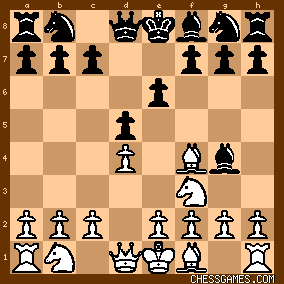
click for larger viewI would have expected 3...BxN from Tchigorin, given his stated preference for Knights over Bishops. Remarkably enough, this position appears only to have been reached four times. Two of these games were between von Scheve and Tchigorin, here and at Monte Carlo 1902. 4. e3
4. Ne5 and 4. c4 look better. The only other time this move was played here was in the game between the same contestants at Monte Carlo 1902! 4... Bd6
Tchigorin played 4...Nf6 when the same two players squared off a year later. von Scheve won that later game. Both the text and 4...Bd6 are reasonable choices, and neither Tchigorin's victory here not von Scheve's win at Monte Carlo 1902 had anything to do with the opening. 5. Bg3
Not awful, but an unnecessarily passive retreat. 5. BxB or 5. h3 were better. After the text, any small edge von Scheve had enjoyed was gone. 5... Nf6
6. c4
So we have a (sort-of) Queen's Gambit position after all! 6... Nbd7
Too committal. Given Tchigorin's propensity to play Nc6 against the Queen's Gambit, I am surprised that he committed his Knight in this way when he might have kept his options open with 6...0-0; 6...BxB; 6...dxc4; or even just played 6...Nc6 immediately. 7. Nc3
The Tournament Book says that 7. BxB would be favorable to Black, but this conclusion was only reached based on some questionable suggested later moves for both sides: 7. BxB cxB 8. cxd5 [White would be fine after 8. Nc3] Nxd5 9. e4?! [chances would be about even after 9. Nbd2 or 9. Be2]. The position here would yield a small edge to Black after 9...BxN 10. QxB Nb4 [or 10. gxB Nf4] but not after the Tournament Book;s suggested 9...Nf4 after which White equalizes with 10. h3. 7. cxd5 is a good alternative, but the game is about even after that move or after the text. 7... BxB
"Compulsory as White threatens c5 and Nb5." (Tournament Book). Nonsense. While there was nothing wrong with the text, Black would also have been fine after 7...dxc4. 8. hxB c6
9. Qb3 Qc7
"9...Qb6 needed to be considered." (Tournament Book). 9...Qb6 was certainly an option, but the text was also fine, as were several other moves. 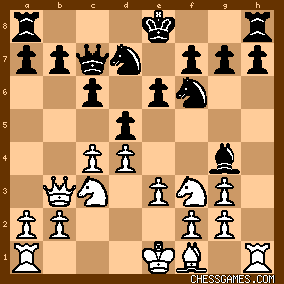
click for larger viewThus far, the only significant development in this approximately even position is the open h-file. That was destined to play a major role in the battle that followed. |
|
Sep-01-19
 | | perfidious: <KEG>, the structure which arose after Scheve played 11.cxd5 is straight out of the modern-day QGD Exchange line, though one clear difference is that Chigorin managed to get his bishop to g4, which can hardly be bad for Black, as that piece is his problem child in most lines of the QGD (except, of course, Chigorin's own 1.d4 d5 2.c4 Nc6). |
|
Sep-01-19
 | | KEG: <perfidious>The position after 11. cxd5 was indeed similar to some QGD lines, but there were important differences. In addition to the Black Bishop on g4, the open h-file gave White attacking chances that I will try to cover in my upcoming posts. There were many pitfalls for the unwary. |
|
Sep-01-19
 | | KEG: Post II
10. Rc1
"Threatening to win a pawn by 11. cxd5 exd5 12. Nxd5 NxN 13. QxN." (Tournament Book). In addition to the text, von Scheve could also have tried 10. cxd5 or 10. Qa3. 10... Rc8
10...dxc4 looks safer, but Tchigorin was not one to back off from a tactical melee. His swashbuckling attitude helped make this game the fascinating struggle it turned out to be; but it also nearly cost Tchigorin dearly. 11. cxd5
A move that, as Perfidius has noted, leads to structures similar to those that appear in many QGD lines. But there were some unusual features here as will soon become apparent. 11... exd5
12. Bd3

click for larger view12... 0-0?!
Recklessly ignoring White's threats. He should have played either 12...a6 or 12...h6. After the text, von Scheve could have won a pawn. 13. Rh4?
"Threatening Bxh7+." (Tournament Book)
"White could win a pawn by 13. Nxd5." (Tournament Book). If 13. Nxd5!, Black would be busted after 13...NxN? 14. Bxh7+ Kh8 15. Bf5+ Kh8 16. BxB (the Bishop on g4 gives White this opportunity, revealing one of the differences between the position here those in the QGD variations mentioned by [perfidious]). Best for Black after 13. Nxd5! would be 13...Qa5+. But White would still be a pawn ahead with excellent winning chances after 14. Nc3. After the text (13. Rh4?), Tchigorin should have been able to equalize with 13...h5, and would also have been fine with 13...Be6. But the great Russian wanted more. 13... BxN
14. gxB Rfe8?!
Still playing for complications rather than simply trying for near-equality with 14...h6 or 14...Qb6. 15. Kf1!
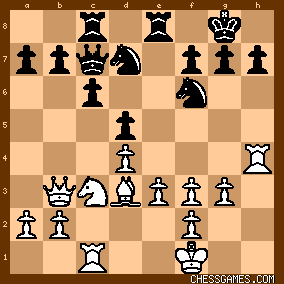
click for larger view"White's plan is to station the King at g2 and thus establish a connection between both Rooks." (Tournament Book). von Scheve was also hoping to double Rooks on the h-file. 15... Nf8
15...Rxe3 came into consideration." (Tournament Book). Not really. If 15...Rxe3 fxR Qxg3, 17. Rf4 shuts down Black's attack (e.g., Nh5 18. Rf5 Rb8 [to prevent Qxb7] 19. Ke2 Qg2+ 20. Ke1 Ng3 21. Rf4 Nh5 22. Bxh7+ KxB 23. Rxf7 and White is the exchange to the good. The text looks good to me. Also reasonable were 15...Red8; 15...Qb6; or 15...g6. 16. Kg2
According to plan. But 16. e4 or 16. Qa3 may have been even stronger. 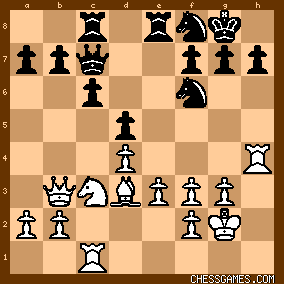
click for larger view16... g6
16...h6 or 16...Ne6 were probably better. After the text (16...g6), the position was: 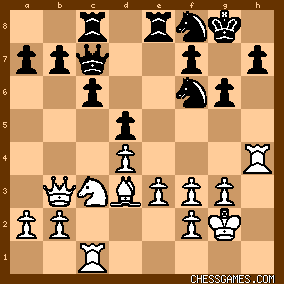
click for larger viewFrom here, the battle truly flared up as I will discuss in my next post on this game. |
|
Sep-01-19
 | | KEG: Post III
17. e4
"!"--(Tournament Book)
"White energetically pursues the attack." (Tournament Book) 17. f4 was another good way for von Scheve to press his advantage. 17. Qa3 also looks strong. 17... dxe4
17...Qb6 may have been a better way to take some of the sting out of von Scheve's attack. 18. fxe4
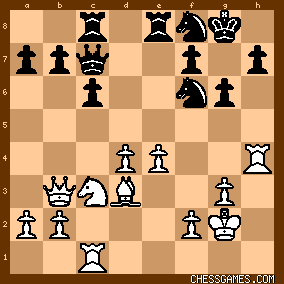
click for larger view18... Qb6?
But this now looks like a mistake by Tchigorin, since von Scheve could now have traded down to what was possibly a winning ending by trading Queens. 18...Red8. 19. Qc4?
Setting a trap (for which Tchigorin did not fall), but missing 19. QxQ which--as noted above--might have yielded a winning endgame for him. After 19. Qc4? the position was:
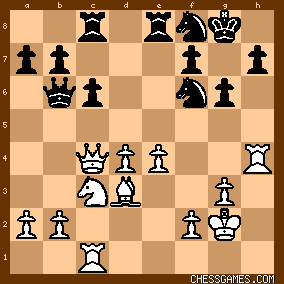
click for larger view19... Rcd8
"Not 19...Qxb2 because of 20. Rb1 followed by Rxb7." (Tournament Book). The Tournament Book is correct that 19...Qxb2 would have been bad in light of 20. Rb1, but then play would continues 20...b5 21. RxQ bxQ 22. Bxc4 with much the better game for White but no Rxb7. 20. e5
"This and his next move lead to interesting complications. Black wins a pawn, but only temporarily." (Tournament Book). While the text was certainly best, Black won a pawn only because of missteps by both sides, the position now being: 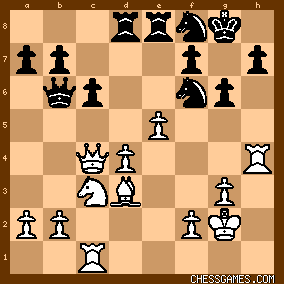
click for larger view20... Nd5?!
Tchigorin decided to take the bait, but 20...g5! was the best way to halt von Scheve's initiative. 21. Ne4?
21. Be4 was much better.
21... Qxb2
"Black can not capture the pawn with impunity because of the threat Ne3+." (Tournament Book). 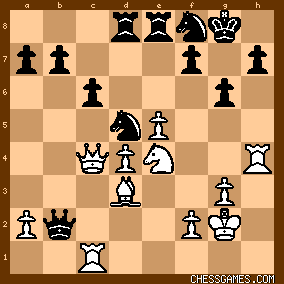
click for larger viewHow should White proceed? |
|
Sep-01-19
 | | KEG: Post IV
22. Rch1 looks attractive, but as von Scheve himself demonstrated after the game, there is a fly in the ointment: 22. Rch1? Ne3+ 23. Kf3 NxQ 24. Nf6+ and now Black gets mated after 24. Kh8 25. Rxh7+ NxR 26. RxN mate. However, Black wins with 24...Kg7! since Black's King can now fleee to f8 after 25. Rxh7+ NxR 26. RxN+ Kf8 leaving Black a full Queen up. The Tournament Book suggested 22. Kf3?, but this simply loses to Ne6! since Tchigorin could then have answered 23. Rb1 with 23...Qxd4. Recognizing the foregoing, von Scheve played:
22. Rc2
This is clearly much better than the Tournament Book's proposed 22. Kf3 and, as the Tournament Book correctly noted, gains a tempo, but Tchigorin had effective answer. The best chance for White was the flexible 22. Re1 after which White has compensation for the sacrificed pawn and about even chances. 22... Qa3
23. Rc1
En route to h1 to double up on the h-file. But Tchigorin should have been able to blunt von Scheve's attack after this move. He should instead have tried 23. Rd2 or 23. Be2. 23... Kg7?
Tchigorin would have been on top with 23...Ne6. If then 24. Nd6 RxN! 25. exR Qxd6 Black would have not only two pawns for the exchange but also a safe defense and excellent chances for counter-attack. Now, von Scheve could have worked his way back into the game, the position now being: 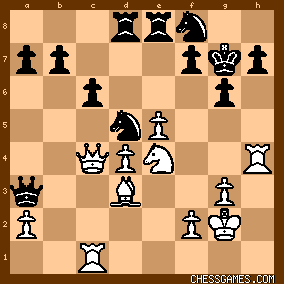
click for larger view24. Rch1?
Pursuing an illusion. He could have righted his ship with 24. Qc2 or even 24. Nd6. 24... h5
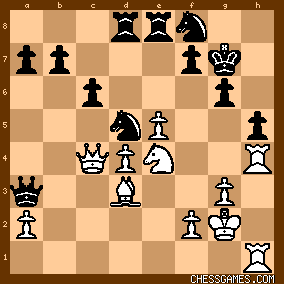
click for larger view25. Bc2?
This could have cost von Scheve the game. 25. Nd6 or 25. Rb1 were the ways to stay in the game, the position now being: 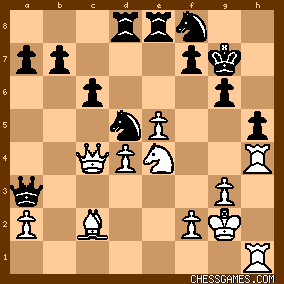
click for larger viewBefore examining what transpired from here, one major point must be made: I don't believe the game score here. I have reached this conclusion for two reasons: 1) We know the score is at best incomplete. The game, according to the original entry in the Tournament Book, the game lasted 85 moves but only 45 were recorded. There is a supplemental source which I will discuss in connection with moves 46-66, but if that source is correct, then the game lasted 66 and not 85 moves and once again the original source was flawed. 2) The next two moves supposedly played by Tchigorin are inexplicable from so great a played. With these two blunders--if the score is correct--Tchigorin turned a winning position into a losing one. I have sprinkled my commentary to this point liberally with ?s, but this is based on what appears in the score (and on this site), not on what I suspect actually happened. My best guess is that the position reached after Tchigorin's 26th move actually occurred over the board, but I suspect it was reached via some other route that I thus far have been unable to reconstruct. Skeptical readers can judge in reviewing the next two alleged moves by Tchigorin that I will discuss in my next post on this game. |
|
Sep-01-19
 | | KEG: Post V
25... Qb2??
I cannot imagine why Tchigorin would have (needlessly) placed his Queen in such a precarious position when 25...Ne6 would have avoided the mess that followed and left him in a likely winning position. 26. Rb1
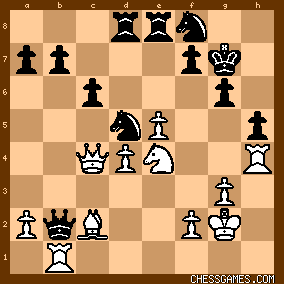
click for larger view26... Nb6?
"Obviously there was nothing better, although it loses back the pawn." (Tournament Book). Hogwash! Tchigorin would have been very much in the game with 26...b5! Now, von Scheve had a winning combination after which he seemed to have a clearly won game, the position now being: 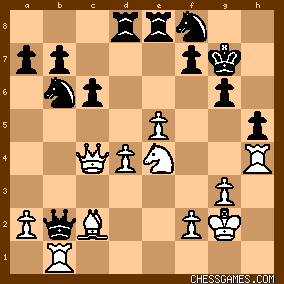
click for larger viewMy rant in my previous post notwithstanding, I do believe that the above position was actually reached. Given some of the upcoming fine play by Tchigorin (i.e., the sort of play Tchigorin fans have come to love and expect from this fabulous player), he managed to turn his losing game into a winning one (with--of course--some assistance from von Scheve). For now, we can enjoy the pretty combo von Scheve now unleashed that brought him to the brink of victory (and a 2-0 record and the lead in the Tournament): 27. Qxf7+!
"!"--(Tournament Book)
27... KxQ
28. RxQ
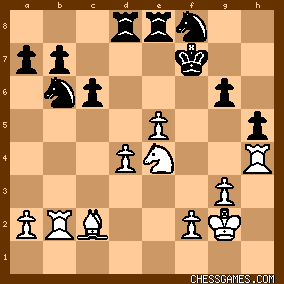
click for larger viewMaterial was even, but von Scheve's position was overwhelming (Fritz +1.77; Stockfish +1.82). It seemed inevitable that he would soon win at least the exchange. 28... Kg7
28...Ne6 or 28...Re7 were probably theoretically better, but none of these moves look attractive. My guess is that Tchigorion knew he was in big trouble, and tried to--and finally managed to--muddy the waters. Other than possibly missing a chance on move 31 (that was a losing option at that point anyway), Tchigorin from here did what we would expect--fight hard to get his less experienced opponent to lose his way. 29. Nd6 Re7
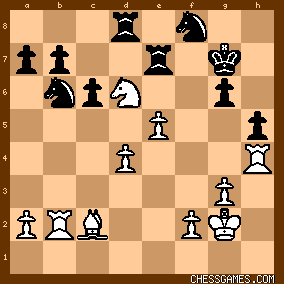
click for larger view30. g4!
30. f4! (Stockfish's suggestion) also looks crushing, but the text looks most logical since it pried upon the h-file. 30... hxg4
31. Rxg4
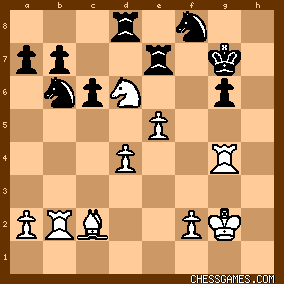
click for larger viewThings certainly looked grim for Tchigorin at this point. But stay tuned. Tchgorin was always an exceptionally resourceful and dangerous player in a tactical shootout, and he managed to turn the game around very quickly. |
|
Sep-01-19
 | | KEG: Post VI
31... Kh6?!
As any computer will tell you, Black's best chance here was to sacrifice the exchange with 31...RxN. Tchigorin's move allows White a clear win, but it also created an illusion that there was now an immediate winning combination. 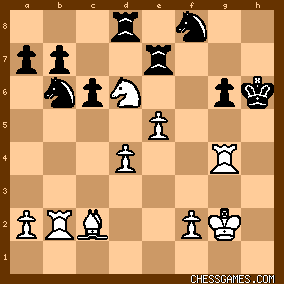
click for larger view32. Rb1
32. Rb3 also would allow the Rook to get to the h-file and was even stronger, but von Scheve's 32. Rb1 didn't really ruin anything. He could also have won with 32. Bxg6 NxB 33. Nf5+ Kh7 34. NxR NxN, but with two Knights for Rook and pawn, Tchigorin might have been able to offer protracted resistance. 32... Red7
32...RxN was again a possibility and was arguably best, but Tchigorin was seemingly egging von Scheve on, tempting him with what may have looked like a quick brilliant win. The position was now:
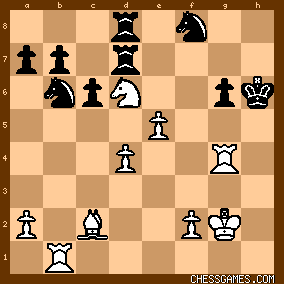
click for larger view33. Bxg6?
"Ingenious but not sound as Black's reply shows. He [von Scheve] should have preceded instead with 33. a4 whereupon Black would have been compelled to give up the exchange by RxN." (Tournament Book). I agree that 33. a4 was an improvement on the text, but: (i) von Scheve still probably had a won game even after the text; and (ii) the clearest way to win here was with 33. Nf5+! Kh7 (if 33....Kh5?? 34. Rh4+ Kg5 35. f4 mate) 34. Rh1+ Kg8 35. Nh6+ Kg7 36 e6 as was pointed out by Schlechter. My only quibble with Schlechter's brilliant line is that 36. f4 would be even more crushing than 36. e6. After 33. Bxg6? the position was:
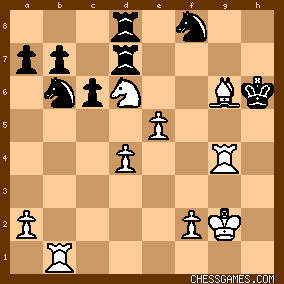
click for larger viewAs the Tournament Book correctly pointed out, 33...NxB would run into 34. Nf5+ Kh7 35. Rh1+ Kg8 36. RxN+ after which Black could delay, but not avoid, mate. But Tchigorin found a much better move:
33... RxN
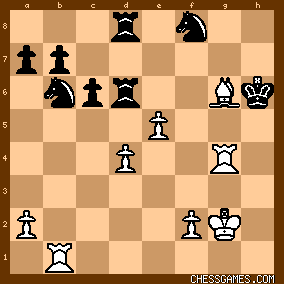
click for larger view34. Bf7
Not 34. exR NxB after which Tchigorin with two Knights for the sacrificed Rook and with the better pawn structure (not to mention the indefensible White pawn on d6) would suddenly have the better chances. 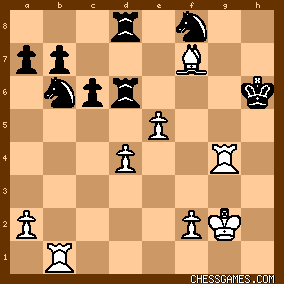
click for larger viewHere, Tchigorin found a brilliant problem-like move: 34... Rg6!
35. BxR
35. Rh1+ Kg7 36. 37. Kf3 Rf8+ also leaves White with a difficult road to victory. 35... NxB

click for larger viewCan White still win? As I will discuss in my next post on this game, any win now would have been difficult, and in practice von Scheve lost his way and Tchigorin managed to obtain a won game within four moves. What a reversal of fortune! |
|
Sep-02-19
 | | KEG: Post VII
36. Rb3?
"?"--(Tournament Book)
"He should be trying to advance the f-pawn with good chances of success, e.g., 36. Kf3 followed by Ke3 [not necessary--see below--KEG]and Ke4 and then f4." (Tournament Book). 36. Kf3 does indeed seem to be the way to play for a win (e.g., 36. Kf3 [which is even better than playing 36. Rh1+ immediately] Rf8+ 37. Ke4 (no need to waste time with 37. Ke3 since 37...Rxf2? loses immediately to 38. Rh1+ Kg7 39. Rhg1) Nd5 38. Rbg1 Rf4+ (38...Ngf4 is no better) 39. RxR NgxR 40. Rg8 and White gobbles up one or two pawns on the Queen-side. After the text (see position below) the wily Tchigorin found a clever way to save the game: 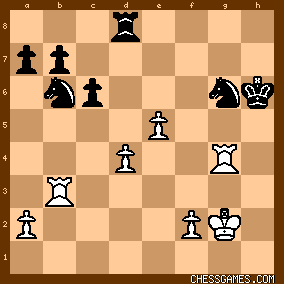
click for larger view36... Nd5!
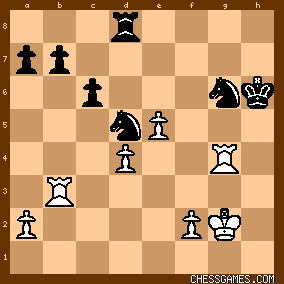
click for larger viewAs noted by the Tournament Book, if von Scheve here had played 37. Rxb7 Tchigorin would--if anything--have had the better chances after 37...Ndf4+ 38. Kh1 Rxd4. 38. Kf3 is probably better than the Tournament Book's suggested 38. Kh1, but this at best yields equality for White. 37. Rh3+
This was von Scheve's only way to try to continue to play for a win. 37... Kg7
38. Rhg3 Nde7
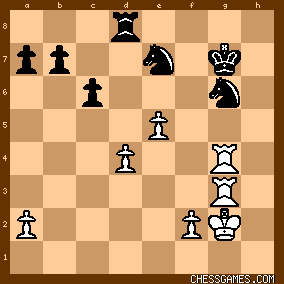
click for larger view39. f4?
"?"--(Tournament Book)
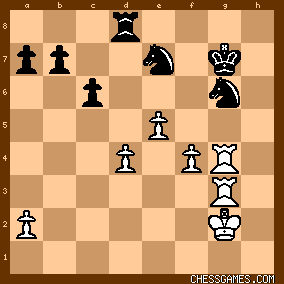
click for larger viewvon Scheve no doubt expected Tchigorin to play 39...Rxd4 after which he would be OK as was shown in the Tournament Book: 40. RxN+! NxR 41. f5. But Tchigorin saw further than did von Scheve and played the subtle winning move: 39... Kf7!

click for larger viewThe full brilliance of Tchigorin's idea apparently did not dawn on von Scheve until after he played his next move. 40. f5?
Unaware of the danger. He should have played 40. Rd3, though it is doubtful that even with this move he could have saved the game. After 40. f5?, the position was:
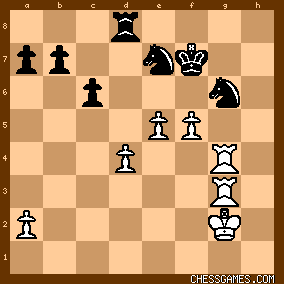
click for larger viewBlack to move and win. |
|
Sep-02-19
 | | KEG: Post VIII
40... Nxf5!
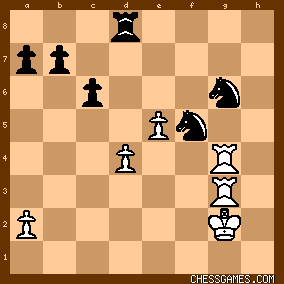
click for larger view"[White] dare not capture the Knight at once on account of check at h4." (Tournament Book). von Scheve seemingly missed the above-noted nuance that Tchigorin obviously noticed. This oversight cost von Scheve the game. 41. e6+
There was nothing better.

click for larger view41... Kxe6
41...Ke7 42. RxN NxR 43. KxN Rxd4 was more accurate, but the text also left Tchigorin up a Pawn in a Rook and Pawn ending that was almost certainly a theoretical win. After 41...Kxe6 the position was:

click for larger viewFrom here, von Scheve had nothing better than to exchange down to a theoretically lost Rook and Pawn ending. 42. RxN+ Kf7
Tchigorin had obviously calculated this resource. 
click for larger view"The German master (von Scheve) so far has made a splendid fight, but the position is against him [i.e., he's lost--KEG]. He has no means to save the exchange [i.e., having to return the exchange--KEG] and with one pawn to the bad must lose." (Tournament Book]. 43. R3g4
von Scheve had nothing better.
43... Ne3+
Even better than 43...Nh4+.
44. Kf3 NxR
45. RxN Rh8
45...Ke6 or 45...b5 may have been more accurate, but the text was almost certainly sufficient to win. The position after 45...Rh8 was:
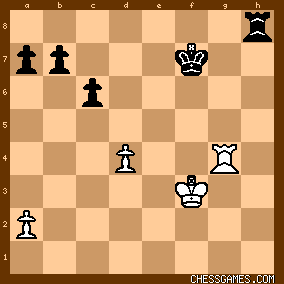
click for larger viewWith an extra pawn and the better pawn structure, Tchigorin's position was almost certainly a winning one. But Rook endings can be tough, and resignation by White would be premature. Unfortunately, the original game score ends here with the note "...and Black after a long endgame." (Tournament Book). The game score on this site also ends here.
However, my edition of the Tournament Book contains a supplement from "Jacques N. Pope of Ann Arbor, Michigan USA" which purports to give moves 46-66. His alleged source is said to be "New-Yorker Staats Zeitung 21st February 1901." As I discussed in my comments on the first round game at Monte Carlo between Marshall and Tchigorin, this source gave a questionable continuation from the end of the game score. In addition, if the source is correct here, then the game almost certainly didn't last 85 moves, since the win in the remaining King and Pawn ending after move 66 was trivial (and should hardly require another 19 moves even if von Scheve had perversely decided to play on). While I am therefore far from confident that moves 46-66 as given in the Tournament Book supplement are reliable, I will discuss them in my remaining posts on this game. |
|
Sep-02-19
 | | KEG: Post IX
The fact that the Rook and Pawn ending after 45...Rh8 was probably a theoretical win for Tchigorin does not mean the win was easy. As the sequel revealed (assuming the supplement source can be believed), Tchigorin understood the demands of the position far better than did von Scheve. 46. Rg2 Kf6
47. Ke4
The game will obviously be decided on the Queen side, so that is where von Scheve's King headed. 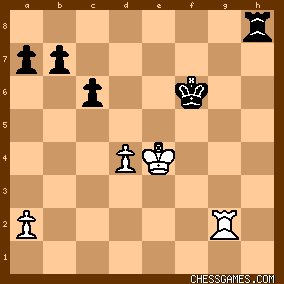
click for larger view47... Rh7
48. Kd3 Ke6
Tchigorin followed suit, and also sauntered over to the Queen-side. 49. Kc4 Kd6
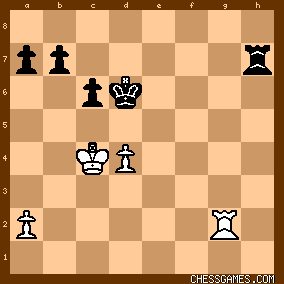
click for larger view50. a4
von Scheve's idea of limiting Tchigorin's action on the Queen side (e.g., b5) was understandable. But he should have limited the squares available to the Black King first with 50. Rg6+. 50... Rh1?
The only really bad move by Tchigorin in this ending. He needed to create a refuge for his King with 50...a5 or 50...b6 before abandoning his second rank. Alternatively, he could first have just played 50...Kc7. The text gave von Scheve an opportunity to lock up the 7th rank with 51. Rg7!, the position after 50...Rh1? being: 
click for larger viewAfter 51. Rg7!, it is far from clear that Tchigorin could have won. But... 51. Rg6+?
After this lemon, von Scheve didn't get another chance. 51... Kc7
Tchigorin's Queen-side was now secure, and he could settle down to the task of creating a pawn steamroller. 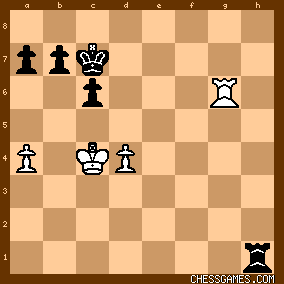
click for larger viewFrom this point, von Scheve seemed to lose the thread of the game while Tchigorin's play was nearly flawless. 52. Kc5?
He should have played either 52. a5 or 52. Rg7+. 52... Rh5+!
Driving von Scheve's King back with gain of tempo. 53. Kc4

click for larger view53... a5!
Leaving von Scheve's King with no way to advance or even more laterally on his 4th rank. The end was clearly near. 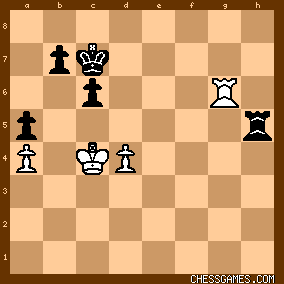
click for larger view54. Rg7+
Too late!
54... Kb6
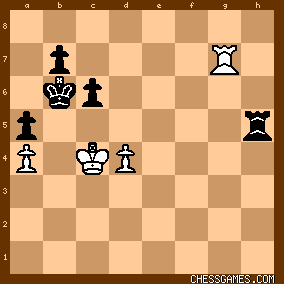
click for larger view |
|
Sep-02-19
 | | KEG: Post X
55. Re7
Useless. He should either have played 55. Rg3 (to prevent Rh3 by Black) or maybe 55. Kc3 or 55. Kb3 (to be poised to defend his a-pawn). Stockfish also suggests 55. Rg6 (though for the life of me I don't see the point). 55... Rh1
This was certainly good enough,but I would simply have played 55...Rh3 and won the a-pawn via Ra3 and Rxa4. 56. Kb3
Taking advantage of the chance to defend his a-pawn. 56... Rh3+
One move earlier might have been simpler, but Tchigorin still had the game well in hand. 57. Kb2 Rd3
This is probably the explanation for Tchigorin's by-passing 55...Rh3. The text leaves von Scheve's position hanging by a thread. 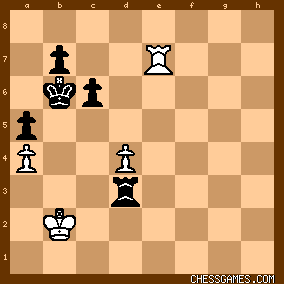
click for larger view58. Rd7 Ka6
He could perhaps have saved a tempo by playing 58...Ka7 immediately. Perhaps the looming 60-move time control explains this move. 59. Ka2 Ka7

click for larger view60. Rd8 b6
61. Kb2 Kb7
62. Kc2
62. Rd7+ was the best way to prolong resistance. The text is clever but hopeless, the position now being: 
click for larger view62... Kc7
62...Ra3 would also be good.
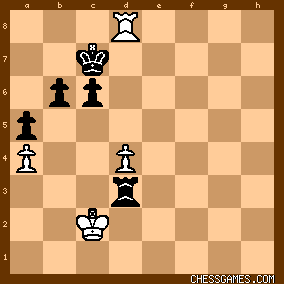
click for larger view63. KxR
This was tantamount to resignation, but his chances after 63. Rh8 (theoretically best) were about nil. 63... KxR
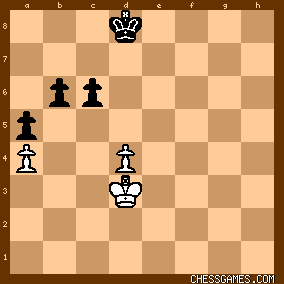
click for larger view64. d5?!
A final trap.
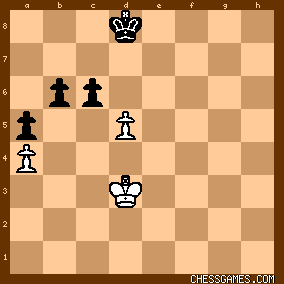
click for larger viewTchigorin did not fall for it (64...cxd5?? draws because after 65. Kd4 Kd7 66. Kxd5 and White has no way to make progress). 64... b5!
65. dxc6 b4
66. Kc4 Kc7
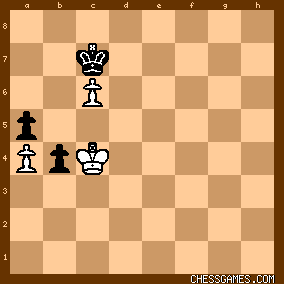
click for larger view0-1
He must lose his c-pawn (if 67. Kb5 [or 67. Kc5 or 67. Kd5] the b3 wins immediately) and then eventually succumb to Tchigorin's protected passed b-pawn. (A final note, I don't see how this game--if the supplemental score is correct--could have been extended from here to move 85 as the Tournament Book says was the actual length of the game). |
|
|
|
|





